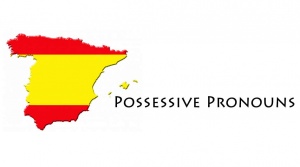Difference between revisions of "Language/Spanish/Grammar/Possessive-Pronouns"
Reginashrly (talk | contribs) (→Examples: Perbaikan kesalahan pengetikan) Tags: Mobile edit Mobile web edit |
|||
| Line 1: | Line 1: | ||
[[File:Spanish-Possessive-Pronouns.jpg|thumb|none]] | [[File:Spanish-Possessive-Pronouns.jpg|thumb|none]] | ||
In | Hola Spanish learners! | ||
In today's lesson you will learn how to use the Possessive Pronouns in Spanish. | |||
Please, feel free to edit this page if you think it can be improved. | |||
Enjoy your language learning journey! :) | |||
= As Determinant = | = As Determinant = | ||
These Possessive Pronouns are used before the object. The next table will show you the Possessive Pronouns as determinant corresponding with the personal pronouns | These Possessive Pronouns are used before the object. | ||
The next table will show you the Possessive Pronouns as determinant corresponding with the personal pronouns: | |||
{| class="wikitable" | {| class="wikitable" | ||
!Personal P. | !Personal P. | ||
| Line 67: | Line 79: | ||
* La botella '''tuya''' tiene agua (your bottle has water) | * La botella '''tuya''' tiene agua (your bottle has water) | ||
* Los libros '''de ella''' son muy pesados (her books are very heavy) | * Los libros '''de ella''' son muy pesados (her books are very heavy) | ||
{{#seo: | |||
|title=The possessive Pronouns in Spanish | |||
|description=Here is a lesson to learn how to use The possessive Pronouns in Spanish. | |||
|og: | |||
}} | |||
[[Category: Spanish/Intermediate]] | |||
Revision as of 19:53, 20 December 2019
Hola Spanish learners!
In today's lesson you will learn how to use the Possessive Pronouns in Spanish.
Please, feel free to edit this page if you think it can be improved.
Enjoy your language learning journey! :)
As Determinant
These Possessive Pronouns are used before the object.
The next table will show you the Possessive Pronouns as determinant corresponding with the personal pronouns:
| Personal P. | Possessive P. |
|---|---|
| Yo | Mi |
| Tú | Tu |
| Él/Ella/Usted | Su |
| Nosotros/Nosotras | Nuestro/Nuestra |
| Vosotros/Vosotras | Vuestro/Vuestra |
| Ustedes/Ellos/Ellas | Su |
Examples
- Mi mamá está casada con mi papá (My mom is married to my dad)
- Tú y tu hermano son iguales (You and your brother are the same)
- Nuestras mascotas son muy traviesas (Our pets are sleepers)
As Pronoun
These Possessive Pronouns are used after the verb "Ser". The next table will show you the Possessive Pronouns as pronoun corresponding with the personal pronouns.
| Personal P. | Possessive P. |
|---|---|
| Yo | Mío/Mía |
| Tú | Tuyo/Tuya |
| Él/Ella/Usted | Suyo/Suya-De él/ella/usted |
| Nosotros/Nosotras | Nuestro/Nuestra |
| Vosotros/Vosotras | Vuestro/Vuestra |
| Ustedes/Ellos/Ellas | Suyo/Suya-De ustedes/ellos/ellas |
Examples
- La computadora es mía (the computer is mine)
- Los lentes son vuestros (your glasses are yours)
- La manzana es de ella (the apple is hers)
Note #1: in both cases, as the real possessive pronouns (su and suyo/suya) are the same of él/ella/usted and ustedes/ellos/ellas, generally we use "de"+personal pronouns
Note #2: you can use the Possessive Pronoun after the object, (they are very informal)
- La botella tuya tiene agua (your bottle has water)
- Los libros de ella son muy pesados (her books are very heavy)
